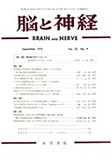Japanese
English
- 有料閲覧
- Abstract 文献概要
- 1ページ目 Look Inside
緒言
脳血管系の先天性異常は従来剖検によつて発見されてきたが,近年脳血管撮影の普及により,生体でも見出されるようになつた。
内頸動脈・脳底動脈吻合遺残もその1つで,これは胎生期脳にみられるprimitive trigeminal artery, primi—tive acoustic artery, primitive hypoglossal artery等が残存したもので,最近脳血管撮影により発見された報告例が増加しつつある。しかしこれらの臨床的意義については議論があり,一定の結論はみられていない。
Two cases of the persistent hypoglossal artery are reported with reference to angiographic features and clinical significance.
Case 1. A 35 year old woman complained of occasional headache, nausea and ataxia. Two years later, she noticed double vision and dizziness. Left carotid angiography revealed the persistent hypo-glossal artery (Figs. 1 & 2).
Case 2. A 39 year old man was suffered from twitch of right fingers for 20 years, then he noticed unsteadiness of gait. Left carotid angiography showed the persistent hypoglossal artery (Figs. 3, 4 & 5). These symptoms disappeared spontaneously.
Angiographic features of the persistent hypoglos-sal artery in Towne's and lateral projections are pre-sented in Figs. 6 & 7. The hypoglossal artery divides from the internal carotid artery at the height of the first or second cervical vertebra,runs parallel to it before curving rostrally with convexity at the base of the skull, enters the skull through tke canal of the hypoglossal nerve, and then passes medially and rostrally, and terminates as the basilar artery.
In axial view, the persistent hypoglossal artery runs rostrally along the anterior rim of the foramen magnum after passing the hypoglossal canal (Figs. 8 & 9).
We emphasize that the carotid angiography in axial projection is important for the diagnosis of the presistent hypoglossal artery.
We collected 50 cases of the persistent hypo-glossal artery in the literatures. The signs, sym-ptoms and clinical significance of this artery were summarized as follow ;
1) No clinical signs or symptoms
2) Compression of cranial nerves
3) Associated intracranial vascular lesions
4) Ischemia of the brain stem
5) Ischemia of the homolateral internal carotid artery
6) Associated brain tumors
7) EEG abnormality
8) Others, such as malformations
We concluded that the signs and symptoma of our cases were due to the temporary ischemia of the brain stem.

Copyright © 1970, Igaku-Shoin Ltd. All rights reserved.


